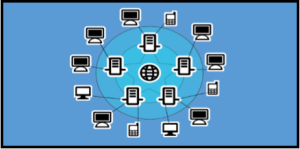Understanding the 3 Layers of the Internet
 We think of the internet as horizontal, spreading out across the globe.
We think of the internet as horizontal, spreading out across the globe.
But there is a vertical dimension as well, with digital data reaching up into the clouds and down into dark, subterranean places.
“Most of us regularly use the surface level of the internet,” says attorney and FindLaw tech writer Eric Sinrod. “But there are other deeper and darker levels.”
The Surface Web
This is where we spend most of our time. As you’re reading this post, you are navigating the surface web. The same is true when you’re sending an email, posting to Facebook, tweeting on Twitter, shopping on Amazon, searching on Bing, listening to Pandora, watching YouTube videos, having a Snapchat, scanning Instagram, reading online news, or buying and selling on eBay.
“This part of the internet probably is the most familiar to you, so you might think that it comprises the vast majority of the internet,” writes Sinrod. “Wrong! According to a recent blog by Vinay Kumar, the surface web comprises only 4 percent of the internet.”
The Deep Web
Do you use a cloud application for storing data? Then you’ve visited the deep web.
Its defining characteristic is that it cannot be accessed through Google or any other search engine. No keyword or search algorithm will get you there. The bulk of information – text data, audio files, video and images – is private, sensitive and personal. Experts like Kumar estimate that up to 96 percent of the internet is comprised of the deep web.
Deep web content includes email and chat messages, private content on social media sites, electronic bank statements, electronic health records (EHRs) and other content accessible over the internet but not crawled and indexed by search engines like Google, Yahoo, Bing or DuckDuckGo.
From Tech Target: “The reasons for not indexing deep web content are varied. It may be that the content is proprietary, in which case the content can only be accessed by approved visitors coming in through a virtual private network. Or the content may be commercial, in which case the content resides behind a member wall and can only be accessed by customers who have paid a fee. Or perhaps the content contains personal identifiable information, in which case the content is protected by compliance regulations and can only be accessed through a portal site by individuals who have been granted access privileges.”
The Dark Web
“This is a place on the internet where you really should not want to go,” writes Sinrod. “In the dark web, there can be the trafficking of guns, ammunition, drugs, slaves and other illegal items. Criminal activity of various types takes place in the dark web. Usual search engines do not lead to the dark web. Obviously, there are ways of getting into the dark web, but your faithful blogger (moi) has not looked into such access, nor would your blogger tell you about how to access this part of the internet even if he knew.”
Got a tech topic you’d like us to write about? Send a comment and let us know.
Sources:
- FindLaw.com http://blogs.findlaw.com/technologist/2016/09/the-different-layers-of-the-internet.html#more
- What Is – Tech Target http://whatis.techtarget.com/definition/deep-Web




